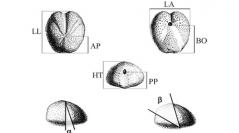

 Comptes Rendus Palevol
2 (6-7) - Pages 597-605
Comptes Rendus Palevol
2 (6-7) - Pages 597-605Several steps of the diversification of the spatangoid Toxaster are described with an analysis of six species distributed over the north-west Tethyan margin, and ranging from the Lower Valanginian to the Barremian. Morphological variation was investigated with the analysis of two parameters (angles), which allowed recognition of three modules on the test. Comparison of ontogenetic trajectories of two reference species (T. granosus kiliani and T. retusus) suggests a peramorphic heterochronic pattern. However, no peramorphocline can be attested when comparisons are extended to adults of the six species. Evolution among these species is partially driven by allometric changes in one module, indicating an important influence of size. On the temporal and spatial scale of the study, the evolution of Toxaster appears globally quite conservative.
Ontogeny, spatangoids, Toxaster, Lower Cretaceous, North-West Tethyan margin